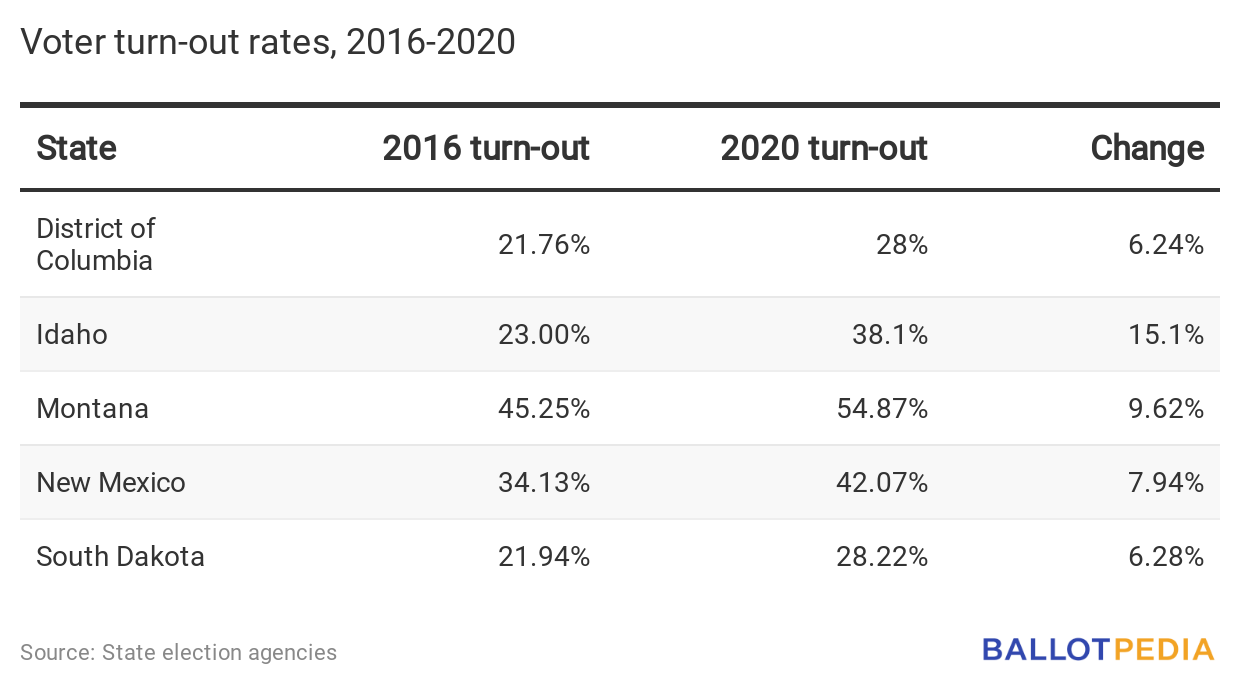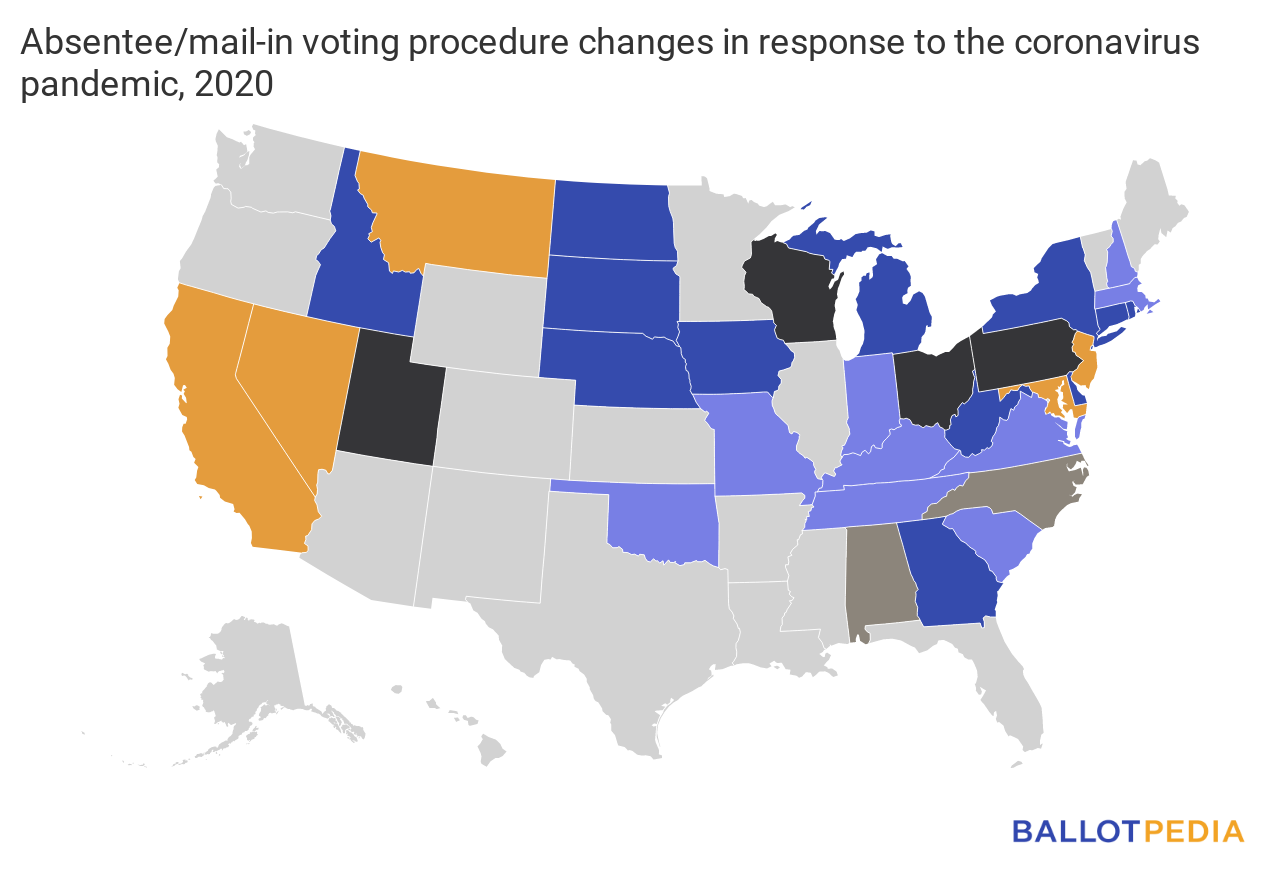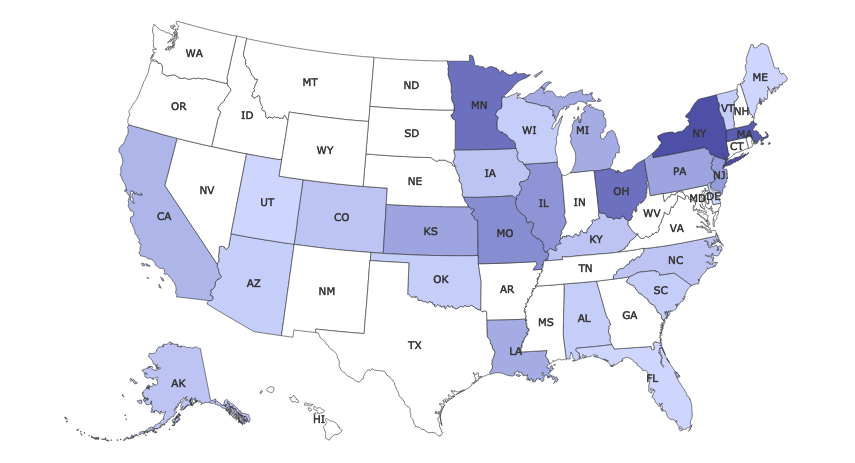June 2 primaries mark highest concentration of voting activity since March
On June 2, nine states held statewide primary elections (and the District of Columbia conducted its district-wide primary). This represented the busiest single day of voting since March 3. The reason? The COVID-19 outbreak prompted a series of election postponements and other modifications.
How many of the June 2 primaries were postponements?
Of the 10 jurisdictions conducting statewide or district-wide primaries on June 2, five had originally scheduled their primaries for an earlier date:
- Idaho (originally May 19)
- Indiana (originally May 5)
- Maryland (originally April 28)
- Pennsylvania (originally April 28)
- Rhode Island (originally April 28)
How did voter turnout on June 2 compare to turnout in 2016?
The table below compares voter turnout in primary elections in 2020 versus 2016. In the five states for which information is available, turnout increased between 6.24 and 15.10 percentage points between 2016 and 2020.
Indiana, Iowa, Maryland, Pennsylvania, and Rhode Island are not included in this table because the figures needed to calculate voter turnout in those states have not yet been fully released.

How many votes were cast by mail, relative to 2016?
Most of the jurisdictions that held primaries on June 2 have not yet released complete information on the number of votes cast by mail. In the District of Columbia, 71.11 percent of all votes cast on June 2 were cast by mail, an increase of 62.82 percentage points over 2016. In Idaho, 57.51 percent of all votes cast were cast by mail, an increase of 43.41 percentage points over 2016.
Of the remaining eight states, seven modified their absentee/mail-in voting procedures, suggesting a possible increase in the share of votes cast by mail in those states:
- Indiana: Absentee/mail-in voting eligibility requirements suspended, allowing all voters to cast ballots by mail.
- Iowa: Mail-in ballot applications automatically sent to all voters.
- Maryland: Mail-in ballots automatically sent to all voters (at least one in-person voting center open in each county).
- Montana: Counties authorized to automatically send mail-in ballots to all voters.
- Pennsylvania: In Allegheny, Dauphin, Delaware, Erie, Montgomery and Philadelphia counties, absentee ballot receipt deadline extended to June 9.
- Rhode Island: Mail-in ballot applications automatically sent to all voters.
- South Dakota: Mail-in ballot applications automatically sent to all voters.
Although New Mexico did not modify its absentee/mail-in voting procedures for the June 2 primary, it already provided for universal absentee voting eligibility (i.e., no excuse required). Iowa, Maryland, Montana, Pennsylvania, and Rhode Island likewise already allowed for no-excuse absentee voting.
Absentee/mail-in voting modifications
Since our June 3 edition, we’ve tracked the following absentee/mail-in voting modifications:
- Alabama: On June 15, Judge Abdul Kallon, of the United States District Court for the Northern District of Alabama, issued a preliminary injunction barring election officials from enforcing witness and photo ID requirements for select voters casting absentee ballots in the July 14 runoff elections.
- Missouri: On June 4, Gov. Mike Parson (R) signed SB631 into law, permitting any registered voter to cast an absentee ballot in any 2020 election, subject to a notarization requirement.
- New York: On June 7, Gov. Andrew Cuomo (D) signed into law legislation extending the submission deadline for absentee ballots in the June 23 election to June 23.
- North Carolina: On June 12, Gov. Roy Cooper (D) signed HB1169 into law, reducing the witness signature requirement on completed absentee ballots from two to one.
- Tennessee: On June 4, the Chancery Court for Tennessee’s Twentieth Judicial District ruled that Tennessee’s absentee voting law, which limits eligibility to those meeting certain criteria, “during the unique circumstances of the pandemic, constitutes an unreasonable burden on the fundamental right to vote guaranteed by the Tennessee Constitution.” The court ordered the state to extend absentee voting eligibility to all Tennessee voters during the course of the pandemic.
- Texas: A three-judge panel of the United States Court of Appeals for the Fifth Circuit stayed a district court decision ordering that all eligible Texas voters be allowed to cast absentee ballots in order to avoid transmission of COVID-19.
To date, 32 states have modified their absentee/mail-in voting procedures. These modifications can be divided into five broad categories:
- Automatic mail-in ballots: Five states (California, Maryland, Montana, Nevada, and New Jersey) have opted to automatically send mail-in ballots to all eligible voters in certain elections to ensure that most voting takes place by mail. These states are shaded in yellow in the map below.
- Automatic mail-in ballot applications: Twelve states (Connecticut, Delaware, Georgia, Idaho, Iowa, Michigan, Nebraska, New York, North Dakota, Rhode Island, South Dakota, and West Virginia) are automatically sending mail-in ballot applications to all eligible voters in certain elections. These states are shaded in dark blue in the map below.
- Eligibility expansions: Nine states (Indiana, Kentucky, Massachusetts, Missouri, New Hampshire, Oklahoma, South Carolina, Tennessee, and Virginia) have expanded absentee voting eligibility in certain elections. These states are shaded in light blue in the map below.
- Deadline extensions: Four states (Ohio, Pennsylvania, Utah, and Wisconsin) have extended absentee/mail-in ballot request or submission deadlines in certain elections. These states are shaded in dark gray in the map below.
- Other process changes: Two states (Alabama and North Carolina) have made other modifications to their absentee/mail-in ballot procedures in certain elections. These states are shaded in light gray in the map below.

Litigation tracking
To date, we have tracked 98 lawsuits and/or court orders involving election policy issues and the COVID-19 outbreak. Beginning this week, in each issue of The Ballot Bulletin, we’ll shine a spotlight on what we think is one of the more interesting recent events in this area. Click here to view the complete list of lawsuits and court orders.
This week, we turn our attention to a case out of California, Gallagher v. Newsom.
- Case name: Gallagher v. Newsom
- Case number: CVCS-20-0912
- State of origin: California
- Court: Sutter County Superior Court
- Summary: On June 12, Judge Perry Parker, of the Sutter County Superior Court, issued a temporary restraining order suspending Gov. Gavin Newsom’s (D) Executive Order N-67-20. The order, issued June 3, had permitted counties to consolidate polling places in the Nov. 3 general election, provided they offer three days of early voting. Parker’s order came as the result of an action filed by two Republican state Assembly members, James Gallagher and Kevin Kiley. Gallagher and Kiley alleged Newsom’s order usurped the legislature’s authority, in violation of the state constitution. Parker enjoined Newsom’s order pending further proceedings in the case.
- Court documents:
Legislation tracking
To date, we have tracked 196 bills that make some mention of both election policy and COVID-19. States with higher numbers of relevant bills are shaded in darker blue on the map below. States with lower numbers of relevant bills are shaded in lighter blue. In states shaded in white, we have tracked no relevant bills.
Legislation related to elections and COVID-19, 2020
Current as of June 16, 2020


